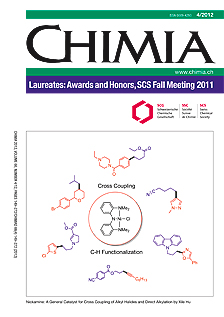Application of Explicitly Localized Molecular Orbitals to Electronic Structure Calculations
DOI:
https://doi.org/10.2533/chimia.2012.178Keywords:
Correlation energy, Local møller-plesset second-order perturbation theory (local mp2), Molecular orbital localization schemes, Regional localized molecular orbitals (rlmo)Abstract
We have recently generalized the method for localizing orbitals on a set of predefined molecular fragments [Phys. Chem. Chem. Phys. 2012, 14, 546]. The regional localized molecular orbitals (RLMO) are well suited for exploiting the locality of electronic correlation at post-Hartree-Fock level of theory. In this paper, the adequacy of RLMO representation is tested in the second-order local Møller-Plesset (LMP2) perturbation theory. Two model systems, namely, n-pentadecane and trans-retinal, are considered. Adequacy of RLMO/LMP2 method is discussed in conjunction with 'exact' MP2 and Pipek-Mezey LMP2 calculations. It is demonstrated that RLMO/MP2 method reduces correlation space and reproduces more than 99% of the correlation energy.Downloads
Published
2012-04-25
Issue
Section
Scientific Articles
License
Copyright (c) 2012 Swiss Chemical Society

This work is licensed under a Creative Commons Attribution-NonCommercial 4.0 International License.
How to Cite
[1]
P. de Silva, M. Makowski, J. Korchowiec, Chimia 2012, 66, 178, DOI: 10.2533/chimia.2012.178.







